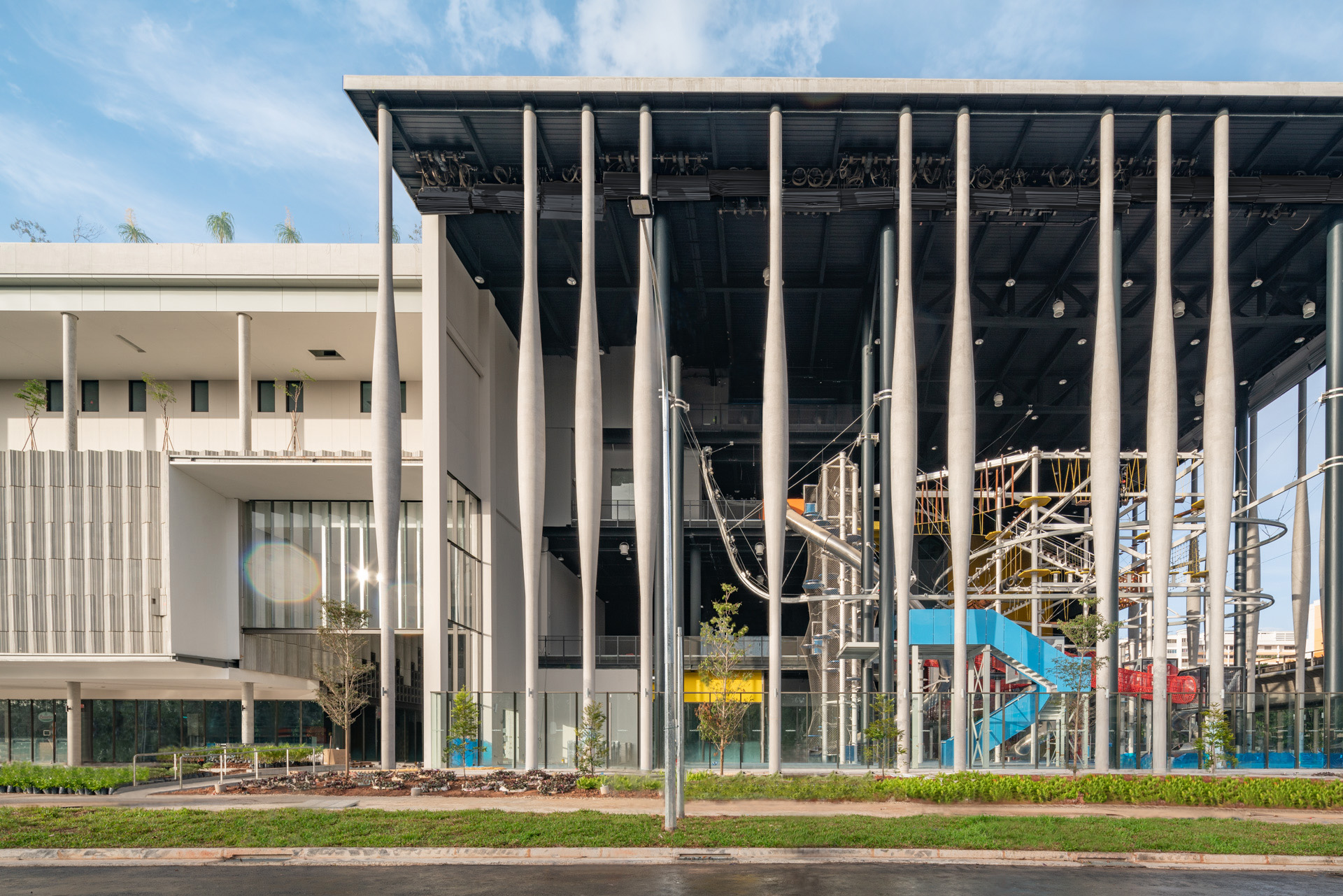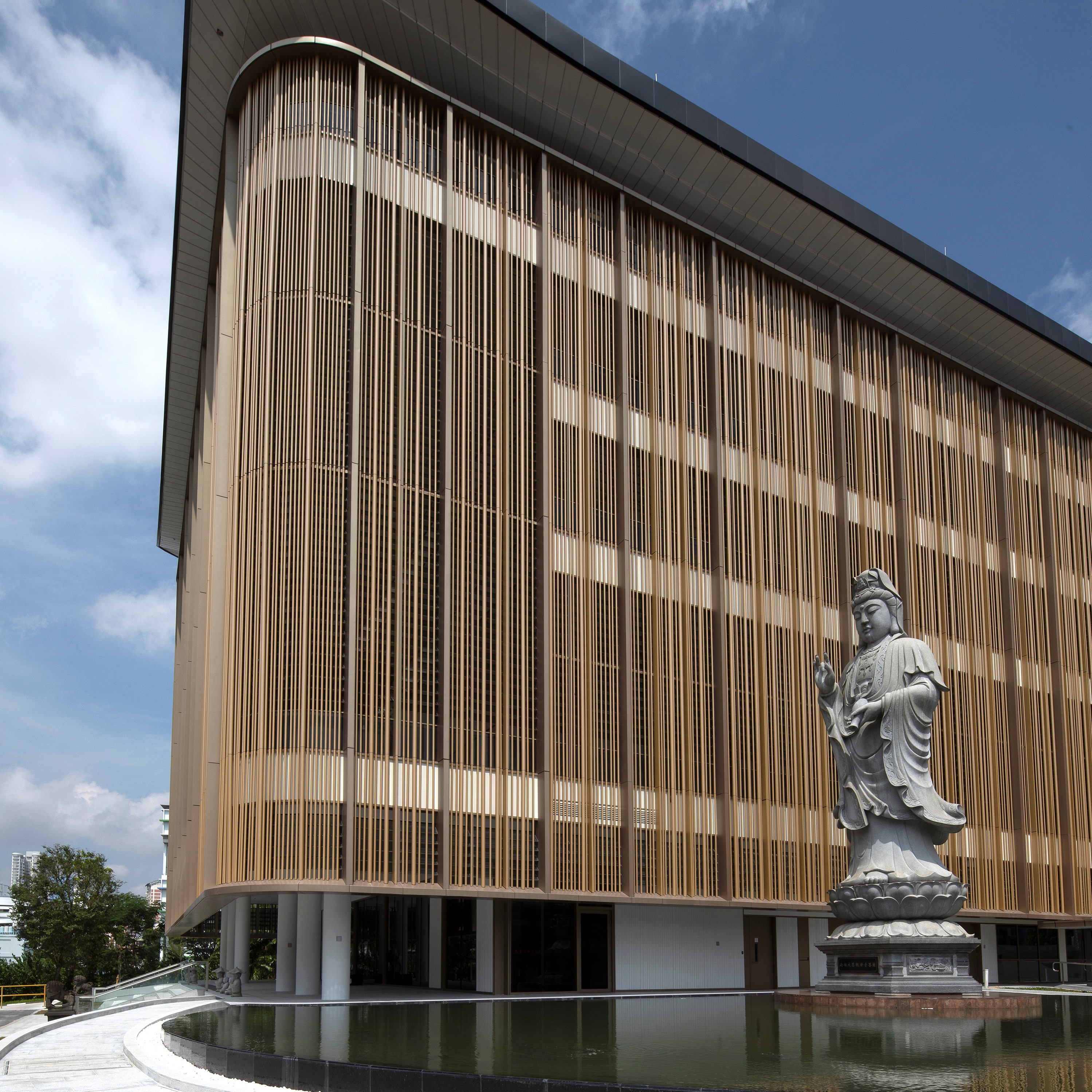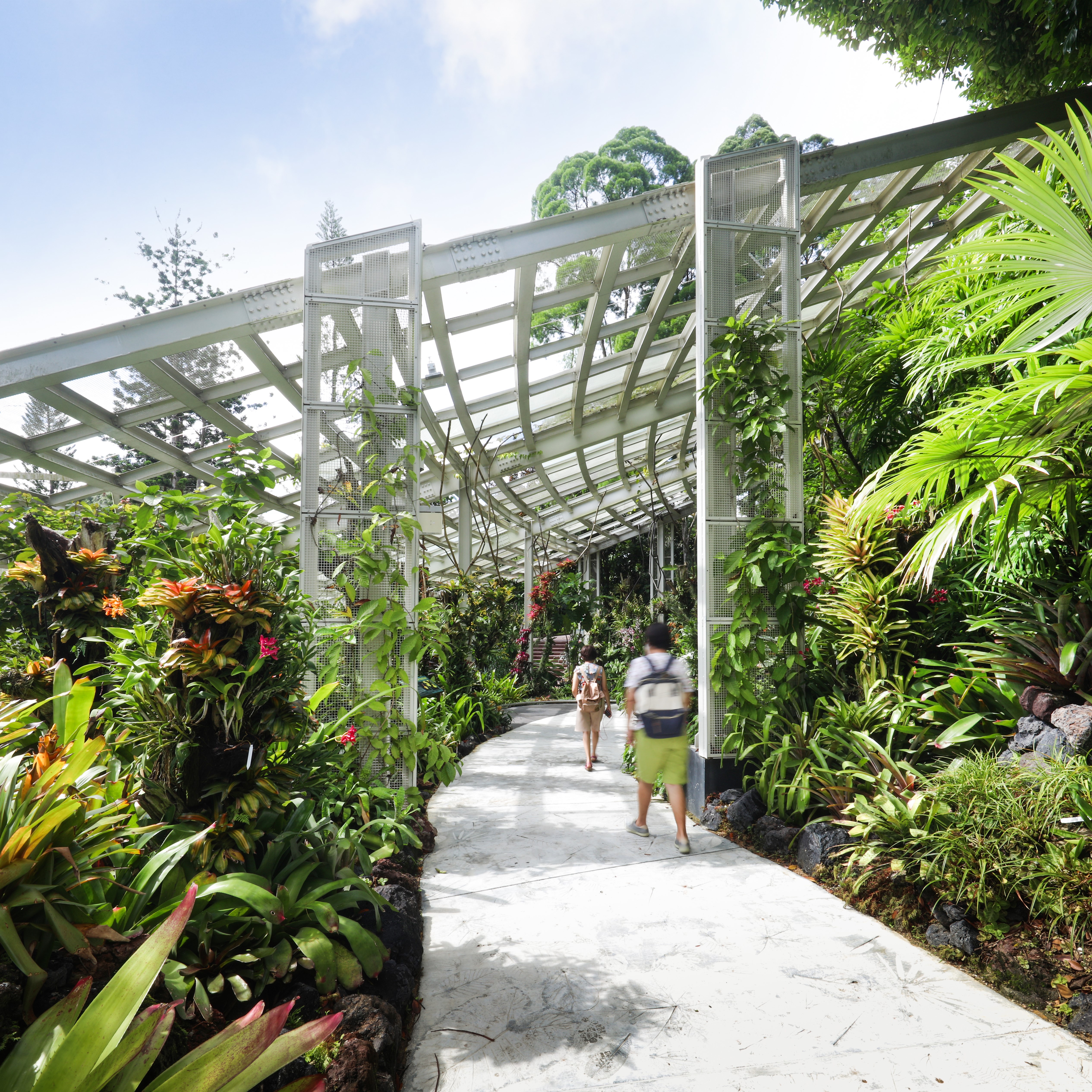Home Team NS Khatib Clubhouse: Duties of Representation
Whether you are used to approaching the town of Yishun by train or by car, the journey has long been associated with the pristine, gently winding spaciousness of Lentor Avenue, lined with large overhanging trees and the vast water body of Lower Seletar Reservoir. The idyllic character of this route has been of late disrupted somewhat with a vibrant presence. The new Home Team NS Khatib clubhouse stands out amidst the greenery and attracts a second look with its sharp textures and fun-filled interior.
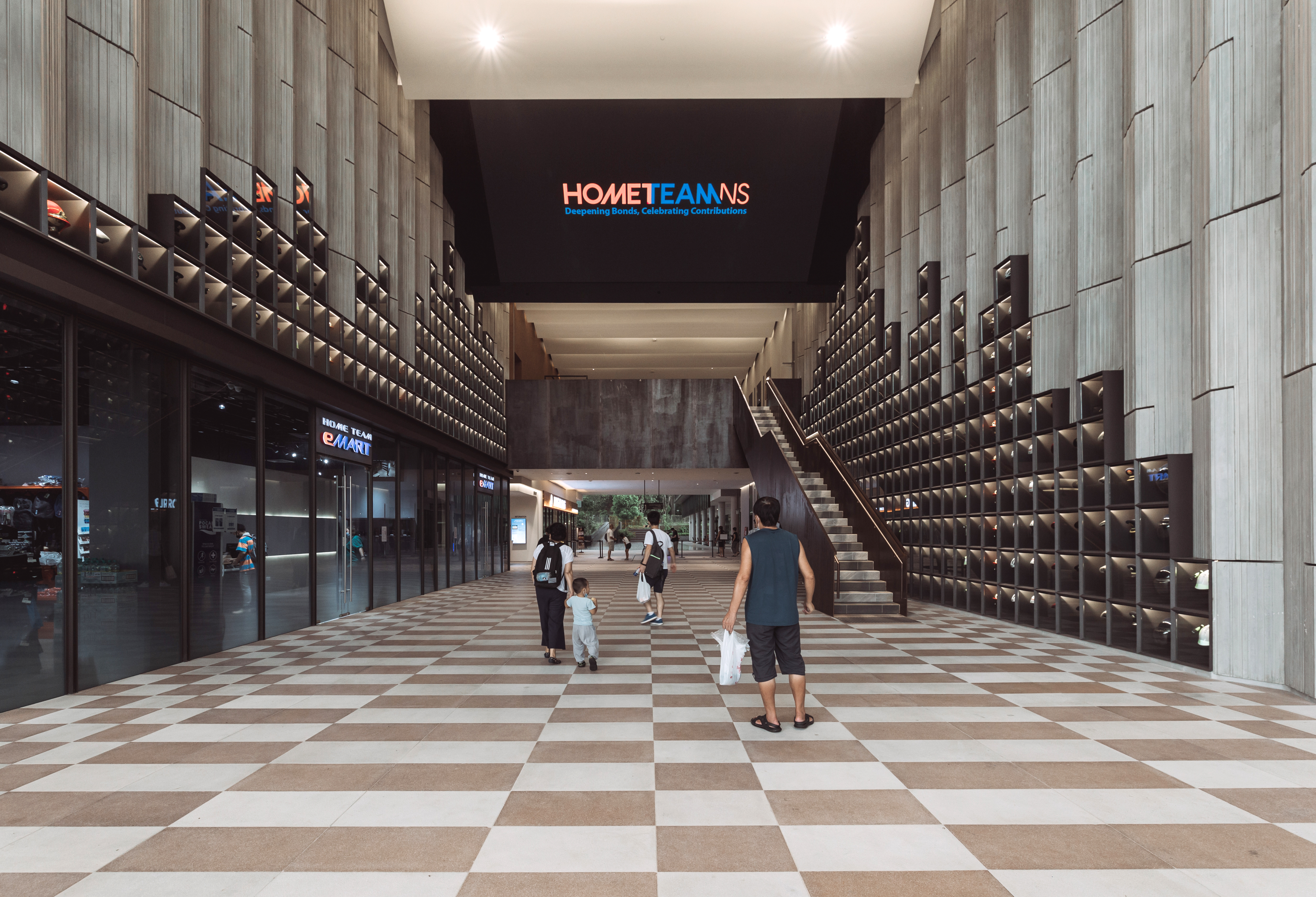
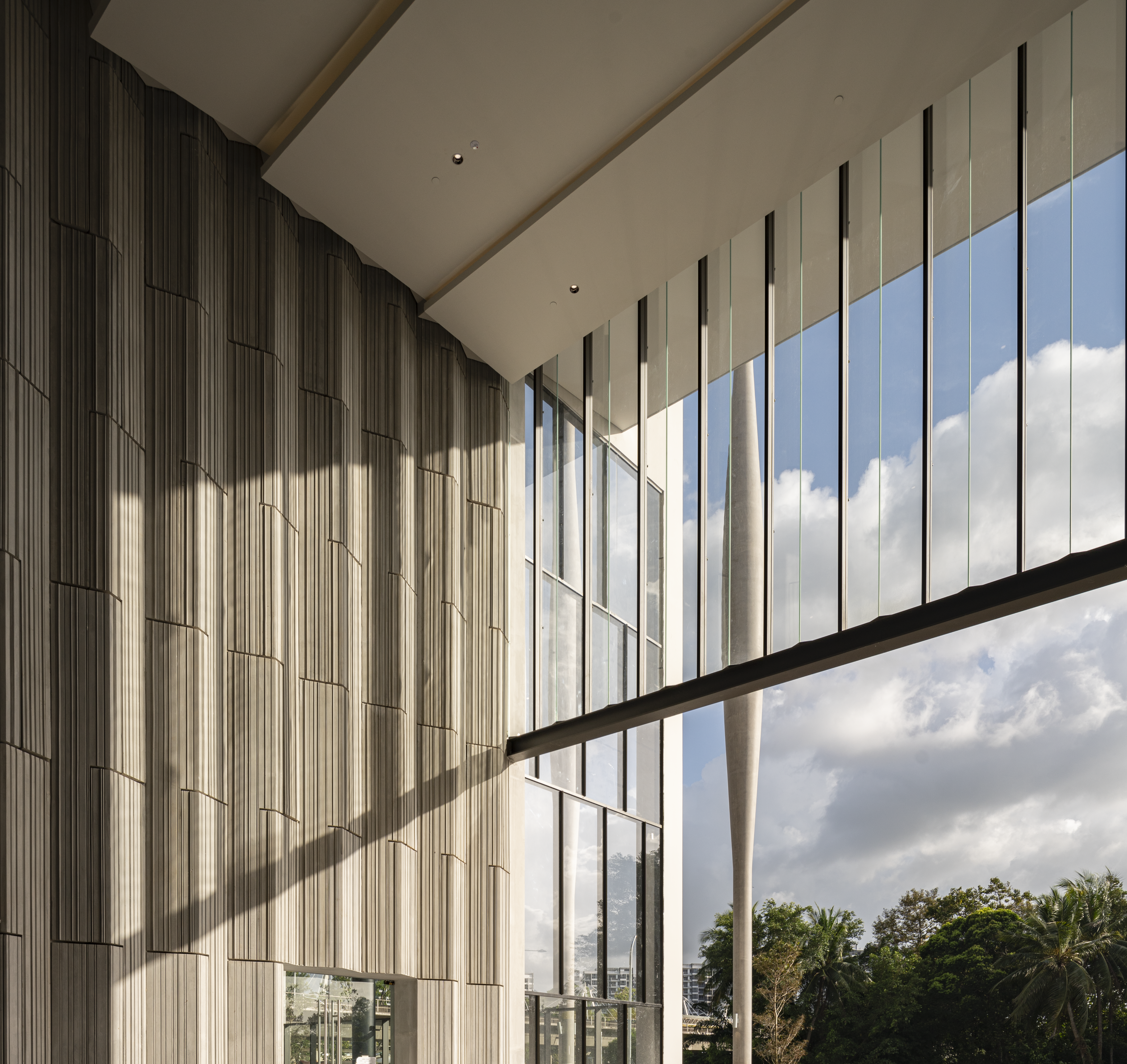
While we cannot wait to enter (a discussion on) this architecture, it may be better to first understand what Home Team NS is, and what the clubhouse is doing here.
Home Team NS is the association for over 200,000 Singaporeans who have served their national service in the Singapore Police Force or Singapore Civil Defence Force. The other organisation similar to this would be SAFRA, the recreational association for national servicemen of the Singapore Armed Forces. The clubhouses serve to keep servicemen engaged and motivated while creating a more approachable public face to its organisations.
These associations are not rooted in any particular locale as they are offshoots of national institutions, but they do need their facilities to be accessible to members, which is why Home Team NS already has clubhouses in Balestier, Bukit Batok, Chinatown and Tampines. In its nature the facility falls somewhere between a private entertainment complex and a public facility, the latter because its active members are largely heartlanders and by affiliation, their families.
Home Team NS Khatib is sited at the edge of several zones but not quite in any of them. Located at the southern fringe of the public housing estate, its neighbours are also Kampong Kampus, the nature-inspired campus of Ground Up Initiative promoting sustainable living and hands-on culture, and Orto, a "leisure park" that is a rustic collective of eateries and facilities offering outdoor activities such as fishing, futsal and paintball. Yishun Walk, the road that provides access to the clubhouse ends in a cul-de-sac. Without looking at the map, one would not know that it is a mere 50metres away from linking up with Lorong Chencharu, the road that serves the agricultural enterprises of Sembawang.
In this extensive space, contextual associations are as yet unformed but still waiting to be made. The architecture sets itself up well for connection. As the lead architect Ar. Ng San Son of DP Architects explains, the parti diagram has always been a grid bisected by 2 crossing axes, a main thoroughfare leading from the HDB estate to the entrance form Yishun Walk (and potentially beyond), and perpendicular to this, another minor passage leading in from the roadside. The plan is thus divided into 4 main programmatic blocks, 2 solids and 2 voids diagonally arrayed like in a checkerboard. The first void is the swimming pool in an open corner and the other is a four-storey high covered but open-sided adventure arena. The two solid blocks hold key programs such as the banquet hall, the bowling alley, food and beverage joints, fitness gym and other members' facilities.
The minor axis ends in a side gate to the park connector which cyclists and pedestrians can use to reach the complex from Khatib MRT. The main thoroughfare from the drop-off is the main circulation of the building as the lifts and staircases tap off from here. The through connection to the community park in the north appears to me as a symbolic gesture of outreach and promises a synergy with the heartland even if it may end up seeing less traffic.
The planning thus plugs the building into the established infrastructure of the city. It is more interesting that on a metaphysical level, the architectural expression has kinship with the wilder, less structured neighbours to the south and west, even if the planning does not as yet connect to them physically. For I see in the bulbous columns of the adventure arena a vivid echo of the bottle tree, the emblem of the bottle tree park (now renamed as Orto) that has anchored the identity of this area for the past decade or so. The striped relief of the precast facade panels evoke viscerally the bark of old trees.
The capacity for architecture to embody meaning and invite interpretation is in no small part due to the architects' exploration of form. The belief in architecture to still play a part in representation, beyond accommodating functions and just being available, is apparent here. Architectural elements announce themselves even as they do their jobs. Thus, while slender columns enable the porosity into the slides and swings of the adventure arena, they do not quietly stand aside without retaining some attention first. Floor tiles are not just anti-slip surfacing to walk on but are patterned to remind one of the banded facade of the Hill Street Fire Station.
The instinct to embellish elements is not unlike what we see in WOHA's work, but it also possesses here an earnestness to derive its articulation from aspects of the brief and site.

While we cannot wait to enter (a discussion on) this architecture, it may be better to first understand what Home Team NS is, and what the clubhouse is doing here.
Home Team NS is the association for over 200,000 Singaporeans who have served their national service in the Singapore Police Force or Singapore Civil Defence Force. The other organisation similar to this would be SAFRA, the recreational association for national servicemen of the Singapore Armed Forces. The clubhouses serve to keep servicemen engaged and motivated while creating a more approachable public face to its organisations.
These associations are not rooted in any particular locale as they are offshoots of national institutions, but they do need their facilities to be accessible to members, which is why Home Team NS already has clubhouses in Balestier, Bukit Batok, Chinatown and Tampines. In its nature the facility falls somewhere between a private entertainment complex and a public facility, the latter because its active members are largely heartlanders and by affiliation, their families.
Home Team NS Khatib is sited at the edge of several zones but not quite in any of them. Located at the southern fringe of the public housing estate, its neighbours are also Kampong Kampus, the nature-inspired campus of Ground Up Initiative promoting sustainable living and hands-on culture, and Orto, a "leisure park" that is a rustic collective of eateries and facilities offering outdoor activities such as fishing, futsal and paintball. Yishun Walk, the road that provides access to the clubhouse ends in a cul-de-sac. Without looking at the map, one would not know that it is a mere 50metres away from linking up with Lorong Chencharu, the road that serves the agricultural enterprises of Sembawang.
In this extensive space, contextual associations are as yet unformed but still waiting to be made. The architecture sets itself up well for connection. As the lead architect Ar. Ng San Son of DP Architects explains, the parti diagram has always been a grid bisected by 2 crossing axes, a main thoroughfare leading from the HDB estate to the entrance form Yishun Walk (and potentially beyond), and perpendicular to this, another minor passage leading in from the roadside. The plan is thus divided into 4 main programmatic blocks, 2 solids and 2 voids diagonally arrayed like in a checkerboard. The first void is the swimming pool in an open corner and the other is a four-storey high covered but open-sided adventure arena. The two solid blocks hold key programs such as the banquet hall, the bowling alley, food and beverage joints, fitness gym and other members' facilities.
The minor axis ends in a side gate to the park connector which cyclists and pedestrians can use to reach the complex from Khatib MRT. The main thoroughfare from the drop-off is the main circulation of the building as the lifts and staircases tap off from here. The through connection to the community park in the north appears to me as a symbolic gesture of outreach and promises a synergy with the heartland even if it may end up seeing less traffic.
The planning thus plugs the building into the established infrastructure of the city. It is more interesting that on a metaphysical level, the architectural expression has kinship with the wilder, less structured neighbours to the south and west, even if the planning does not as yet connect to them physically. For I see in the bulbous columns of the adventure arena a vivid echo of the bottle tree, the emblem of the bottle tree park (now renamed as Orto) that has anchored the identity of this area for the past decade or so. The striped relief of the precast facade panels evoke viscerally the bark of old trees.
The capacity for architecture to embody meaning and invite interpretation is in no small part due to the architects' exploration of form. The belief in architecture to still play a part in representation, beyond accommodating functions and just being available, is apparent here. Architectural elements announce themselves even as they do their jobs. Thus, while slender columns enable the porosity into the slides and swings of the adventure arena, they do not quietly stand aside without retaining some attention first. Floor tiles are not just anti-slip surfacing to walk on but are patterned to remind one of the banded facade of the Hill Street Fire Station.
The instinct to embellish elements is not unlike what we see in WOHA's work, but it also possesses here an earnestness to derive its articulation from aspects of the brief and site.

Restraint in the broad strokes have however helped this architecture. Unlike the clubhouses of SAFRA which tend to be colourful and flamboyant, there is a deliberate attempt here to be more disciplined and dignified in expression. This sets a distinct public character for Home Team NS. The neutrality of the grid, muted palette of greys and whites as well as the clear distinction of structure and cladding allow the building to co-exist with its various contexts.
To further allow the institution to speak of its history, the architects has specially integrated a heritage gallery along the main thoroughfare showcasing the over 20 different types of head gear used by different vocations in the Home Team. Tall angled panels along the side entranceway are used by the client to celebrate different milestones of the organisation. There is an impressive amount of design coordination done on the interior, extending to details in the banquet hall and the pre-function space.
It should also be pointed out that with a substantial quantum of core internal programs and a clear compartmentation of the tenants, this clubhouse has avoided a "mall-ification". I am referring to the adoption of a shopping-mall format by so-called community buildings such as clubhouses and recent integrated community hubs, where a large part of the building is set aside as a shell to house an array of external vendors.
As much as any reservist fireman or policeman, the various constituents of the community and members of the public will need to reckon with the physical presence of this new clubhouse in its place. Such is architecture, always an unstable confluence of identities and obligations. As a facility for its members, there is no doubt that the clubhouse will be immensely well-received. With its well-considered architecture, the Home Team NS Khatib clubhouse also promises to grow into its role as a public space and a public piece of architecture in Yishun.
Restraint in the broad strokes have however helped this architecture. Unlike the clubhouses of SAFRA which tend to be colourful and flamboyant, there is a deliberate attempt here to be more disciplined and dignified in expression. This sets a distinct public character for Home Team NS. The neutrality of the grid, muted palette of greys and whites as well as the clear distinction of structure and cladding allow the building to co-exist with its various contexts.
To further allow the institution to speak of its history, the architects has specially integrated a heritage gallery along the main thoroughfare showcasing the over 20 different types of head gear used by different vocations in the Home Team. Tall angled panels along the side entranceway are used by the client to celebrate different milestones of the organisation. There is an impressive amount of design coordination done on the interior, extending to details in the banquet hall and the pre-function space.
It should also be pointed out that with a substantial quantum of core internal programs and a clear compartmentation of the tenants, this clubhouse has avoided a "mall-ification". I am referring to the adoption of a shopping-mall format by so-called community buildings such as clubhouses and recent integrated community hubs, where a large part of the building is set aside as a shell to house an array of external vendors.
As much as any reservist fireman or policeman, the various constituents of the community and members of the public will need to reckon with the physical presence of this new clubhouse in its place. Such is architecture, always an unstable confluence of identities and obligations. As a facility for its members, there is no doubt that the clubhouse will be immensely well-received. With its well-considered architecture, the Home Team NS Khatib clubhouse also promises to grow into its role as a public space and a public piece of architecture in Yishun.
